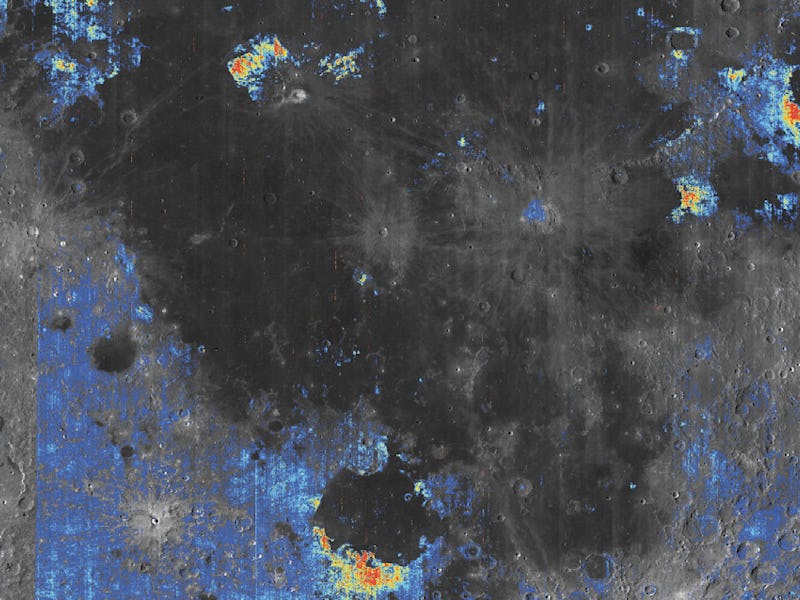Water in the Moon's Interior Could Help Fuel Our Trips to Mars

Imagine a service station on the Moon, where local “Lunar” brand water is available for your journey to Mars. It may sound like something out of a sci-fi novel, but new research suggests we might be closer to making this a reality than we previously thought.
A new study has shown that there are likely large deposits of water scattered across the Moon’s surface, and the findings could have a huge impact on future space exploration. The discovery, outlined Monday in the journal Natural Geoscience, posits that ancient volcanic deposits located across the Moon actually consist of pyroclastic glass beads that contain traces of water. As the magma from these volcanoes once ran 250 miles deep within the Moon, these findings imply that the lunar mantle could actually be surprisingly rich in water.
The amount of water in each glass bead is minimal, but these volcanic deposits are huge, so there’s a lot to work with. “Any time you find water at any place beyond Earth it’s pretty exciting for a number of reasons,” lead author Ralph Milliken told Inverse. Milliken is an assistant professor in the Department of Geological Sciences at Brown University.
In the context of a place like the Moon, where we don’t think about water in terms of life — like we might with Mars — water deposits could serve other crucial purposes. “If you ever wanted to establish a more permanent human presence or outpost on the Moon,” said Milliken. “You’re going to want to extract resources from that place as much as you can.”
Water is heavy — and expensive — to get off the Earth on a spacecraft. If there was a place to make a pitstop on our way into deep space, that could be a game-changer.
Scientists have speculated that there could also be water ice in the shadowy regions of the lunar poles, but it’s much more difficult to access those regions. “The fact that we may have water in these pyroclastic deposits, it may be much easier to access that,” said Milliken.
The other exciting implication of these findings is that they suggest these volcanic deposits are rich in hydrogen, which is important to fuel and could imply a new, Moon-based resource ready for extraction.
Volcanic deposits have been spotted by orbiters across the Moon.
There’s been growing evidence of the presence of water on the moon since 2008, according to Milliken. But original discoveries implied there wasn’t much. Satellites only picked up signs of small amounts of hydrogen on the Moon’s surface, left there by solar winds.
A second discovery of water in 2008 came when scientists analyzed lunar samples collected by Apollo 15 and 17. Trace amounts of water were discovered in a collection of pyroclastic glass beads which had formed from volcanic eruptions billions of years ago.
Milliken’s research, co-authored with Shuai Li, a postdoctoral researcher at the University of Hawaii, examined the large, volcanic deposits unexplored by the Apollo missions — there are a lot of them — to see if they also exhibited signatures of water.
What they found even surprise the researchers themselves. “We were hoping to see signatures of water in volcanic deposits like these, but to be honest, when I started out I thought, ‘Ah, maybe it’s a bit of a long shot,’” said Milliken.
“Nearly all the pyroclastic deposits we looked at seemed to have water, and I thought they might be a little more heterogeneous in that regard; that maybe a few would have it and some wouldn’t. It seems to be a pretty common characteristic of these types of deposits on the Moon, so that was pretty exciting.”
To detect the water-infused pyroclastic beads, the team measured reflected sunlight using an imaging spectrometer that flew aboard India’s Chandrayaan-1 lunar orbiter.
“Different minerals and different compounds will absorb light in different ways, and that kind of acts as a fingerprint for those materials,” said Milliken. “Water — and it either be as H2O, or we often use water to refer to hydroxyl (OH), either of which could be extracted to produce water to drink in theory — has characteristic absorptions.”
These absorption features, matching the volcanic beads discovered on the Apollo missions, were picked by satellite data all over the Moon’s surface.
Milliken says the next step will be to collect actual samples of these pyroclastic glass beads from across the Moon’s surface, so scientists can study them in detail to understand the nature of the water and how much is really there.
A gas station on the Moon? It doesn’t sound so unrealistic now.